We test the new Trek Fuel EXe 2023: the most natural electric bike of the moment
Lightweight electric mountain bikes have become very popular and the proof of this is that the big brands in the sector have made a strong commitment to have at least one model in their catalogue. This is the case of the Trek Fuel EXe, an eMTB very close to a conventional one that comes with the new TQ HPR50 motor and a high level of integration.
After several weeks of riding with it we tell you all its features and the sensations it has given us.

Trek Fuel EXe electric?
After two years of development by the Wisconsin-based brand, the new Trek Fuel EXe has seen the light with a clear objective: to position itself halfway between its lightest E-bike, the E-Caliber, and its most powerful, the Rail.
RECOMENDADO

When must the tubeless tire sealant be replaced? What quantity?
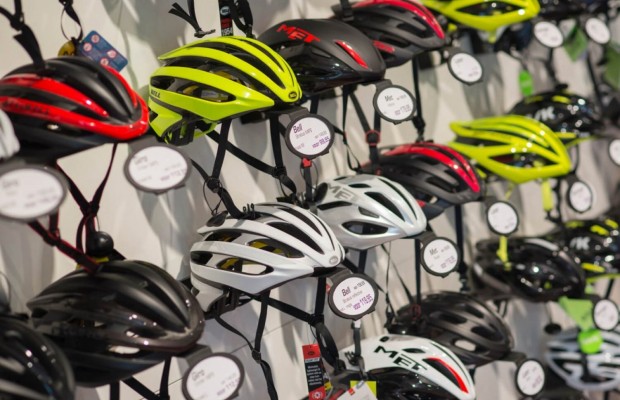
When do helmets have to be changed? Do they have an expiration date?

The real importance of signing up for a race

Don't overlook your nutrition when training in cold weather

The best apps for cycling and mountain biking

25 cycling gifts ideas to get it right
Based on the use of OCLV Mountain carbon, the frame shares the same design as its muscular sister, the Trek Fuel EX 2023. The use of the compact TQ HPR50 system has allowed Trek to design a frame that is almost identical to the muscular frame, optimising and reducing the size of the tubes, especially the diagonal tube that houses the battery.
It is precisely its aesthetics that makes many of those who see it for the first time wonder if the Trek Fuel EXe is really an electric MTB.

All versions have 150 and 140 mm front and rear travel respectively, and 29" wheels, with the option of fitting a 27.5" rear wheel to convert it into a Mullet and gain some handling. The only requirement for the latter is that the MinoLink system must be in the High position.
Trek's ABP (Active Braking Pivot) system consists of a concentric pivot around the wheel axle that improves suspension performance by isolating acceleration and braking forces.
The chainstays have a length of 440 mm. This is quite short when you consider the good wheel clearance, which allows 2.5" tyres to be fitted, leaving plenty of room with stays and chainstays. The standard 148 mm conventional Boost and a 55 mm chainline are used. Just above the junction of the chainstays with the down tube we find a plastic protector that prevents mud accumulation in that joint.
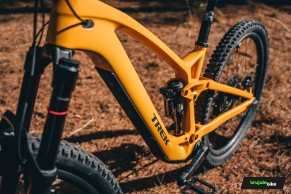
A control panel is integrated into the top tube, within sight and close to the controls for manipulation. That location deprives the Fuel EXe of the Knock Block steering lock, but on our unit, all the components were away from the top tube when the handlebars were turned. Internal cable routing is via channels built into the frame for easy cable maintenance.
Variable Trail Geometry
This Trek Fuel EXe includes the brand's MinoLink system which allows the steering angle to be modified by approximately half a degree, while at the same time modifying the bottom bracket height by between 6 and 9 mm. A simple operation that is carried out with a simple allen key by modifying the position of some levers. This allows you to play with the geometry depending on your preferences or the characteristics of the trail that you are going to find on your routes.

Its geometry complies with current trail standards, with a steering angle of 64.7º to gain downhill capacity, but avoiding an excessively steep pitch that penalises uphill and rolling sections.
The 76.7° saddle angle offers a comfortable and effective pedalling position. A generous 452.2 mm reach in size M and a bottom bracket to ground clearance of 342 mm.
These numbers are with the MinoLink in the Low position, if we decide to change it to the High position, the angles will be increased by 0.5° and its ground clearance will be 349 mm.
As with the design of the tubes, the use of the compact TQ motor has made it possible to develop this geometry, which helps to achieve the brand's goal of a feeling as natural and close to a traditional bike.
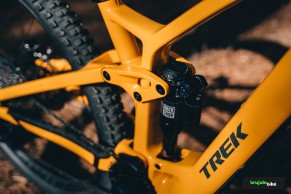
The TQ unit, a step forward in motorisation
At the heart of the Trek Fuel Exe is the TQ HPR50, an engine developed and assembled in Europe by German company TQ. While it may be a new brand to many, it has been making E-bike engines since 2008, but it is only now that it has made a name for itself among the better-known bike brands.
The TQ HPR50 is the manufacturer's flagship unit and is notable for not employing the usual belt and gear system, but instead uses a harmonic drive mechanism with a round design consisting of toothed bearings that perform an oscillating movement, hence its name Harmonic Pin Ring (HPR). This type of motor is characterised mainly by the fact that it works very quietly, almost imperceptible to the human ear. In addition, according to the manufacturer, it is capable of operating at revolutions 3 times lower than the usual motors, resulting in less wear and tear on its internal parts.

It delivers 50 Nm of torque in an unintrusive way, which transforms into a very natural pedal stroke. This is a figure that is a far cry from the most powerful motors, but is above the most conservative motors on the market. Despite having a rated power of 250 W, it is capable of delivering peaks of 300 W.
The unit weighs 1,850 grams, which puts it ahead of its competitors in terms of light weight.
The battery has a capacity of 360 Wh and continues with the same premise of the motor, lightness and small volume to facilitate a good integration in the diagonal tube.
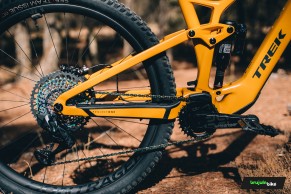
One of its main features is that it can be removed for independent charging, an interesting option if we do not have a charging point where we keep our bike. It is only necessary to loosen a screw and remove the engine cover to remove it. The charging point is located at the top of the diagonal tube, well protected from knocks and bad weather. Another important fact is that it can be fully charged in about 2 hours.
The weight of the battery is 1,835 grams, which leaves the whole set at only 3.9 kg. One of the keys to achieving super light assemblies on this E-bike.
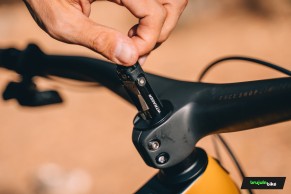
There is also the possibility of extending the battery life by adding a 160 Wh range extender, which is placed in the pedal holder and connected to the charging port, offering around 44% more distance to be covered.
The set is controlled by a discreet control located on the handlebars. It has two buttons that can be used to switch between the three assistance modes (Eco, Mid and High), or to activate the walk assist mode in the event of having to get off on a steep slope.
Integrated display
As already mentioned, the Trek Fuel EXe has a 2-inch O-LED display integrated into the top tube. On this display we have all the information we need to control the electrical part. It includes a tiny button that turns the system on and off. As well as being used to scroll through the four pages showing key metrics such as battery status, riding speed, average speed, rider power, motor power, remaining range... The only thing we missed was the cadence data.
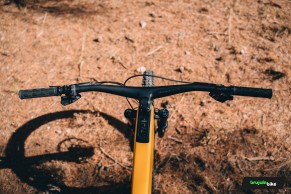
All control in one App
The system connects via Bluetooth to the mobile phone and with the Trek Central App we can control all the parameters of both the engine and our routes. From it we can customise the different modes, adjusting the power, level of assistance and speed of response. We can also use it as a navigator and have at a glance on the mobile phone the speed data, battery level, remaining kms... We can even save our routes or export them to Strava and Komoot.
On top of that, we can pair TyreWiz and AirWiz devices to track tyre and suspension pressures in real time, as well as AXS transmission for shifting adjustments.
High-end set-up
Our test unit was the Trek Fuel Exe 9.9 XX1 AXS, the top of the range model.
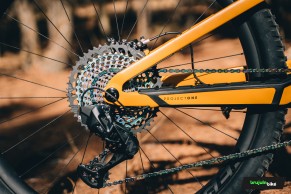
In the drivetrain we find a Sram XX1 Eagle AXS groupset in rainbow finish, well known to all, from which we can highlight the rear derailleur battery, which is powered from the main battery by a thin cable (TQ Smart Box). A way to eliminate the possibility of running out of battery by forgetting to charge it. Although, on the other hand, there is a risk of completely draining the main battery and running out of power to the rear derailleur, but Trek says there are still about 200 shifts left once the main battery is depleted.

The cranks are by E-Thirteen E-Spec Plus, made of carbon and with a 34-tooth chainring (our unit came with a 32T), which in combination with the 10-52 cassette gives us a gear ratio more than enough to climb any slope that crosses our path.
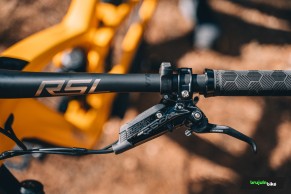
The electronic management of the components takes the quality of the set-up one step higher. We have a suspension set consisting of a RockShox Lyrik Ultimate fork and a RockShox Deluxe Ultimate shock, both equipped with AirWiz valve, which allow us to control their settings from the Trek Central App or from the Sram App. A complement that will help us get the most out of our suspensions, and even serve as a guide for the most inexperienced bikers to help them achieve a more than decent configuration of their fork-shock set-up.

The brakes are a Sram Code RSC with powerful braking and dry feel, accompanied by 200 mm discs that stop this E-bike without any problem.
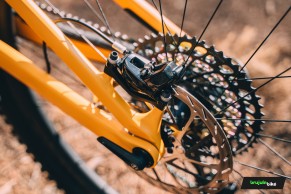
The Sram ecosystem is completed by the 34.9 mm diameter RockShox Reverb AXS dropper seatpost, with travel that varies according to size, from 100 mm for the S to 170 mm for the L-XL. An accessory that has become necessary on bikes designed for this type of cycling.
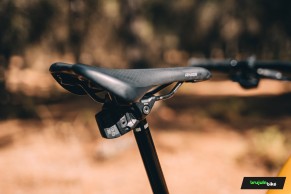
Bontrager signs the rest of the components. The Bontrager RSL handlebar and stem set is 820mm wide, a size that can be compromised on the narrowest of trails. The set includes a complete BITS system multi-tool in the head tube entry.
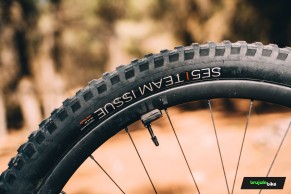
Finally, the Bontrager Line Pro 30 wheels with OCLV carbon fibre rim and 2.5" Bontrager SE5 Team Issue tyres. They are equipped with TyreWiz technology with which you can control the tyre pressure via the aforementioned Apps. Depending on the characteristics of the tyre, the rider's weight and the modality to be practised, it recommends the pressures, as well as having them controlled at all times through its built-in LEDs. These light up green when it is at the correct pressure and red when it is necessary to check it. It is worth mentioning the use on the rear wheel of the rapid drive 108 hub, characteristic for having 108 contact points as its name indicates, which offers an almost instantaneous transmission of power.
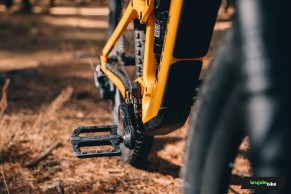
With these components it is possible to stop the scale at 18.7 kg real weight.
Testing the Trek Fuel EXe
The moment of truth arrived. As soon as the test unit arrived, we had the Trek Central App ready to link it up. We made the necessary adjustments, fine-tuned the suspension with the help of AirWiz and then we went out for our first ride. Throughout the ride we were amazed at how quiet the engine is. There is an almost total absence of noise, which is even more noticeable when riding on the road with other E-bikes. We have to pay attention if we want to hear it, as its sound is camouflaged by the rolling of the tyres.
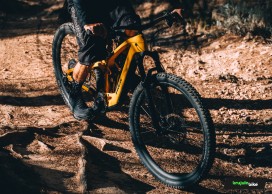
According to a tonality study (the way we perceive sound) carried out by Trek and TQ, the Trek Fuel Exe has a tonality more similar to that of a traditional MTB than an E-bike. This also eliminates a distraction for the rider, focusing more on riding. We can say that it is the quietest E-bike that has passed through our offices so far.
The power delivery is very natural, perfectly matching the pedal stroke, entering smoothly and fluidly. The three assistance modes that the TQ HPR50 has are customisable and dynamic, i.e. they increase or decrease the power delivery based on the force and cadence that we are exerting at any given moment. The latter, together with a few small tweaks to the configuration of the modes made in the App, has allowed us to achieve almost imperceptible jumps between modes.

In the variety of routes we have done, we have been able to see how its torque of 50 Nm is enough to climb any slope or technical section. Moreover, it has a 32T crankset and a 52T Sram cassette.
We have also been able to see how Trek's estimate of between 2 and 5 hours of battery life is not too far off the mark. It exceeds the 2 hours without any problems even when using High mode, however, to get to 5 hours you have to take good care of the battery, but this is something that is facilitated by the estimate of the remaining battery life expressed in time and percentage shown on the screen. This has been our experience with battery life, but as we always say, it depends on several factors.
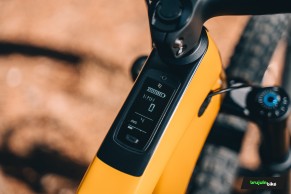
Switching between the three modes is easy thanks to the minimalist push button located on the left side of the handlebar next to the brake lever.
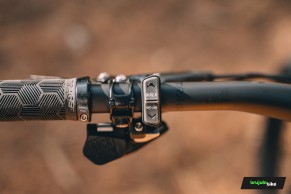
The ECO mode forces us to make an effort in pedalling, especially on hills, where we have to demand a little more from our legs. The MID position has been the most used in our tests. With adjusted consumption and sufficient assistance to tackle climbs without tiring us out. The HIGH mode was reserved for the steepest slopes.
Trek's goal was clear with this bike, to develop a geometry and lightness close to any traditional MTB, which has been possible thanks to having such a compact engine. Having a little less power than other E-bikes on the market translates into a natural riding experience, something that undoubtedly more than justifies the extra effort we have to make in our pedalling.
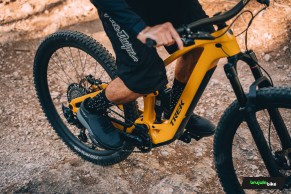
On the move, the position on it is as usual. Once again the TQ engine comes into play, in this case boasting a reduced Q-Factor of 135 mm.
Most of the climbs have been tackled comfortably seated, an ideal position that leaves our weight well positioned. It is reactive in the more technical and steeper areas, thanks in part to the 440mm chainstays.
In twisty areas it's an easy bike to control, giving a lighter feel and making every trail ride feel dynamic. In this type of terrain where you constantly start and stop pedalling, the smooth power delivery from the TQ motor is noticeable. And thanks to its freewheel mechanism, pedalling when it's switched off feels similar to pedalling a muscular MTB. The wide handlebars make it easy to change direction, but the original 820mm may give you a surprise on the narrowest of trails, although it's an easy fix.

It is most enjoyable on the downhills. It is agile when overcoming obstacles, which is an advantage over more powerful and heavier E-bikes. Its large steering angle and wide reach make it easy to get through technical areas safely. Another point in its favour is again the absence of noise from the engine, on the contrary, it is perceived from the multi-tool housed in the stem and the lever of the rear wheel lock.
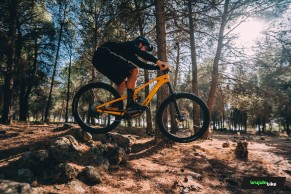
The suspension set-up is balanced and offers a feeling of stability at high speeds. The ABP system gives the rear suspension great poise in all situations, making the most of every millimetre of the shock absorber travel and allowing pedalling with hardly any contamination of our movement. The front end is firmer in the first part of the ride, filtering out minor imperfections in the terrain to a lesser extent. On the other hand, it offers great control as it progresses and the working speed increases.
The tyres are generously ballooned, with a tread pattern that is not overly aggressive, yet they still show a good level of grip and predictable behaviour. For riders who want to push the bike harder, a front tyre with a more pronounced tread pattern may be a good option.

Most of the time we used it with the MinoLink in the Low position, although it is true that when we changed it to the High position we noticed a more reactive steering, being a more balanced geometry when we did routes with a lot of pedalling sections.
Conclusions
In short, the new Trek Fuel Exe has arrived to take the lightweight E-bike concept to the next level, with a compact 50 Nm TQ HPR50 motor that will make you forget you're carrying it and will go unnoticed by your group mates. The smooth power delivery coupled with the right weight distribution and Trail geometry will get you through most terrain with ease.
The level of integration is worth mentioning, with a display built into the top tube and a minimalist controller on the left handlebar, among other things, so that it doesn't look like an electric bike.
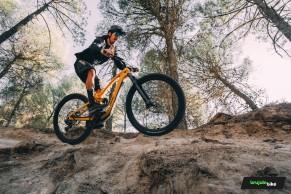
With this bike Trek opens the door to what is possibly the way forward for the lightweight E-bikes of the future. An option to consider for those who want to make the leap to an E-MTB without losing the natural riding feeling of a traditional bike.
Trek Fuel Exe 9.9 XX1 AXS: specifications and weight
- Frame: OCLV Mountain Carbon, removable battery, internal routing, alloy rocker link, 34.9mm seat tube, upper chain guide mount, 55mm chainline, Mino Link, ABP, Boost148, UDH, 140mm travel
- Fork: RockShox Lyrik Ultimate, AirWiz, DebonAir spring, Charger 3 RC2 damper, 44mm offset, Boost110, Maxle Stealth, 150mm travel
- Shock: RockShox Super Deluxe Ultimate AirWiz, RCT2 damper, 205mm x 60mm
- Wheels: Bontrager Line Pro 30, OCLV Mountain Carbon, Tubeless-Ready
- Skewer rear: Bontrager Switch thru-axle, removable lever
- Tyres: Bontrager SE5 Team Issue, Tubeless Ready, Core Strength sidewalls, aramid bead, 120 tpi, 29x2.50"
- Quarq TyreWiz tire pressure monitors
- Shifter: SRAM Eagle AXS, wireless, 12 speed
- Rear derailleur: SRAM XX1 Eagle AXS
- Crank arm: E*thirteen E*spec Race carbon, 34T, 165 mm length
- Cassette: SRAM Eagle XG-1299, 10-52, 12 speed
- Chain: SRAM XX1 Eagle
- Saddle: Bontrager Arvada, austenite rails, 138 mm width
- Seatpost: RockShox Reverb AXS, wireless, 34.9mm
- Integrated Bar Stem: Bontrager RSL Integrated handlebar/stem, OCLV Carbon, 820mm width
- Grips: Bontrager XR Trail Elite, nylon lock-on
- Brakes: SRAM Code RSC, SRAM 6-bolt, 200mm
- Motor: TQ-HPR50, 50 Nm, 250 watt maximum continuous rated power, 300 watt peak power
- Battery: TQ 360 W
- Console: TQ LED display with Bluetooth & ANT+ connectivity
- Controller: TQ handlebar mounted
- Weight: 18.7 kg (size M)